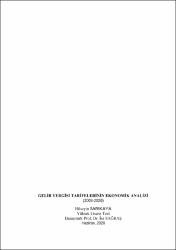| dc.contributor.advisor | Sağbaş, İsa | |
| dc.contributor.author | Sarıkaya, Hüseyin | |
| dc.date.accessioned | 2021-11-01T08:23:55Z | |
| dc.date.available | 2021-11-01T08:23:55Z | |
| dc.date.issued | 2020 | en_US |
| dc.date.submitted | 2020 | |
| dc.identifier.uri | https://hdl.handle.net/11630/9617 | |
| dc.description.abstract | Türkiye’de gelir vergisinde artan oranlı tarife kullanılmaktadır. Bu uygulamanın iki temel avantajı ve amacı bulunmaktadır. Artan oranlı vergi tarifesi ile vergi ödeme gücü tespit edilmekte ve dikey vergi adaleti gerçekleştirilmeye çalışılmaktadır. Bu çalışmada 2003-2020 dönemi gelir vergisi tarifeleri analiz edilmiştir. Gelir vergisi tarifelerinin dikey adaleti sağlamada başarısı ortalama vergi oranı ve marjinal vergi oranı göstergeleri ile incelenmiştir. Bulgular tarifelerin dikey adalet amacını gerçekleştirmede başarılı olduğunu göstermektedir. Tarifelerin uzunluk ve yükseklik farkları sonuçları dönem sürecinde yükseklik farkı sabitken, uzunluk farkının arttığını göstermektedir. Bu bulgu zayıf artan oranlı tarife uygulandığını göstermektedir. Gelir vergisinin konjonktürel esnekliğinin dönem ortalamasının 1,60 olarak gerçekleşmesi gelir vergisi hasılatındaki artışının GSYH artışından daha fazla olduğunu göstermektedir. Bu bulgu uygulanan gelir vergisi tarifelerinin bir çıktısıdır ve gelir vergisinin otomatik istikrar sağlayıcılık işlevi görebilmesi açısından olumludur. Gelir vergisi tarifeleri kullanılarak hesaplanmış reel gelir vergisi bulguları, reel verginin oldukça stabil olduğunu göstermektedir. Bulgular, 2010 ve 2011 hariç, gelir vergisi tarifelerinin enflasyonu dikkate alarak hazırlandığını göstermektedir. | en_US |
| dc.description.abstract | Progressive income taxation is used in Turkey. This application has two main advantages and purposes. The tax payment power is determined and vertical tax justice is tried to be realized by progressive income tax. In this study, income tax tariffs for the period of 2003-2020 is analyzed. The success of income tax tariffs in providing vertical justice is examined by average tax rate and marginal tax rate indicators. The findings show that the tariffs are successful in achieving the goal of vertical equity. The results of the length and height differences of the tariffs show that the height difference increased while the height difference was constant during the period. This finding shows that a weak increasing rate tariff is applied. The cyclical flexibility of income tax is 1.60, which means that the increase in income tax revenues is higher than the increase in GDP. This finding is an output of the applied income tax tariffs and is positive in terms of the fact that income tax can function as an automatic stabilization. Real income tax findings calculated using income tax tariffs show that real tax is very stable. Findings show that excluding 2010 and 2011, income tax tariffs are prepared taking into account inflation. | en_US |
| dc.language.iso | tur | en_US |
| dc.publisher | Afyon Kocatepe Üniversitesi Sosyal Bilimler Enstitüsü | en_US |
| dc.rights | info:eu-repo/semantics/openAccess | en_US |
| dc.subject | Vergi tarifesi | en_US |
| dc.subject | Gelir vergisi | en_US |
| dc.subject | Ortalama vergi oranı | en_US |
| dc.subject | Marjinal vergi oranı | en_US |
| dc.title | Gelir vergisi tarifelerinin ekonomik analizi (2003-2020) | en_US |
| dc.title.alternative | Economic analysis of income tax tariffs (2003-2020) | en_US |
| dc.type | masterThesis | en_US |
| dc.department | Enstitüler, Sosyal Bilimler Enstitüsü, Maliye Ana Bilim Dalı | en_US |
| dc.relation.publicationcategory | Tez | en_US |
| dc.contributor.institutionauthor | Sarıkaya, Hüseyin | |



















